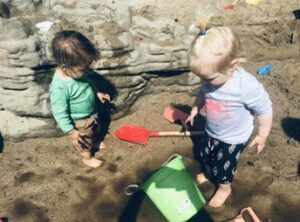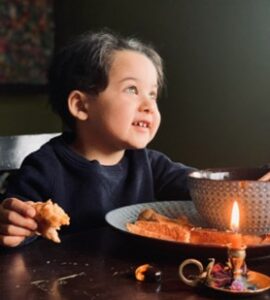Every time that we interact with a child is an opportunity to imbue their soul with a conditioning that has the possibility to nourish their mental and social health for a lifetime.
It sounds like a big responsibility because it is. Children look to those who care for them for the answers on how to live and thrive. Speaking with them on the surface is essential for language acquisition but what it also does is set the stage for how they will learn all about the world and more importantly, how they see themselves.
Too often when we speak to children we seemingly forget how much their tiny bodies and hearts are capable of. We can communicate with them in ways that encourage their capacities to understand, build confidence and grow.
We won’t always get it perfect. Sometimes adults misspeak and it can cause us to worry that we may hinder our little ones. Likely it won’t and what you can do to rectify those difficult feelings is to observe your own intuitive reactions and also notice how your child may have taken your words and actions into their being- their facial expression, demeanor, verbal response or physical reaction. From there, you can always learn and evolve.
A cornerstone to how we should show up in our children’s lives and also bring them to life, is said best by Rudolf Steiner~ that it is our job as caregivers to behave in gesture, speech and spirit, in ways that “are worthy of imitation”. Essentially, we all become what our caregivers were to us. Their voices and gestures become the voices in our heads and outwardly towards others. The way we speak to and about our children will be the frame of reference that they have for understanding the world around them and for building their inner working model of self.
This is why it is so crucial to be intentional with our communication. If you share my wish for children to have the chance to become whole, joyful, confident, self-initiatiators, then you may want to consider the following:
Always Begin with Observation
Sensitively observing our children is the fastest way to begin to clearly understand their needs, temperament, and developmental capabilities. When we are able to see the natural unfolding of how they individually learn, we can thoughtfully meet who and where they are.
To do this successfully also requires slowing down. Babies and children tend to mentally move slower than us at first. Patience is key when “tuning in” and also waiting for children to respond to our voices and the environment. We want to give them the space and time to come to activities, questions, and conclusions on their own. This is a huge part of their learning, both in building the skills to make inquiries and experiments and also to develop a sense of self-efficacy that will last into young adulthood and beyond.
Say What You See
As we go through our day with a child, it is easy to continually put our own biases and opinions on them about what they may be experiencing. The objective with “saying what you see” is to describe to a child what exactly is happening, rather than assuming how they are experiencing it. For example, you may see your child at the playground near another family. They are digging in the sandbox and another child comes and grabs the bucket that they were using. There is a pulling of the bucket back and forth until they both lose grip and the bucket  falls to the ground. Now in that moment you may feel an urge to go and encourage your child to share with their neighbor but “saying what you see” offers a different and selective intervention. If after refraining from the interaction you do decide to approach the children, you may want to “say what you see” instead of offering solutions. “Elliot was using the bucket and Sarah wanted to use it too. Now the bucket is on the floor.”
falls to the ground. Now in that moment you may feel an urge to go and encourage your child to share with their neighbor but “saying what you see” offers a different and selective intervention. If after refraining from the interaction you do decide to approach the children, you may want to “say what you see” instead of offering solutions. “Elliot was using the bucket and Sarah wanted to use it too. Now the bucket is on the floor.”
Then wait. The children may need extra time to navigate the interaction and make decisions. If you see one child going to pick it up, wait again, to see how the other responds. Unless there is a safety issue, all you need to continue to do is “say what you see.” More often than not, sharing your observations out loud is enough for the children to reflect and act accordingly, because they have the desire for harmony. If for some reason, your child wasn’t the one to regain the bucket and expresses upset, you can again objectively say “You were using the bucket and now Sarah has it. That upset you.” The power of being seen, acknowledged and validated can diffuse the big feelings and allow a child to move forward. Magda Gerber the founder of the Educaring Approach says to “let the child be the scriptwriter, the director, and the actor of their own play”. This doesn’t mean that they get to always make the choices about what happens to them and around them, but rather they get to decide how to master the nuances of social situations and challenges that they will inevitably face.
Label things, Not People
Speech is a tool. We can use it to support a child in both learning something new and also in developing self confidence. We know that labeling can impact a person’s self image when used to describe their traits or tendencies.
It is good to label objects or actions to a child, particularly during caregiving activities to aid in their understanding, predictability, and attention.
For example, when changing a baby’s diaper we want to tell them what will happen next, each step of the way, keeping it simple and repeating if necessary.
“Daddy is going to change your diaper now. I need to take off your pants…Now I will wipe you, the wipe might be a little cold because it is wet. It will make you clean.”
Walking a little one through these steps each time will build their confidence and attachment. In addition, we want to simultaneously avoid labeling them. For example, if they are wiggling a lot or scooting away from you, rather than saying “you sure are difficult today or you are always so fussy”, you may develop a more amenable child if you reframe your words to say, “You aren’t ready to have your diaper changed just yet. I want to get you cleaned up so we can move on to the next activity. We can change your diaper together. If you are uncomfortable, we can pause.”
We can always tell the truth while also being respectful of a child’s behavior and experience. Pediatrician, Emmi Pikler made the observation that “if the adult notices communications of the child and responds accordingly, then the child will continue to attempt to communicate.” When we label a person or respond with impatience it can crumble our chances of successful communication and also lead to a child internalizing undesirable thoughts about necessary tasks or themselves.
Trust the Struggle
Struggle is a normal part of life, whether we like it or not.
 Childhood educator Magda Gerber also said that “if we can learn to struggle, we can learn to live. Learning to fall, getting up again and moving on is the best preparation for life.”
Childhood educator Magda Gerber also said that “if we can learn to struggle, we can learn to live. Learning to fall, getting up again and moving on is the best preparation for life.”
If you agree with that, then you can understand the value in not speaking to a child while they are working hard at something. We sometimes feel the pull to narrate our children when they are focused on a task. We are proud of them and want them to know that and also encourage them to keep going. We may see them struggling to climb a tree or taking their first steps and want to give them a physical boost, especially if they are requesting support. But doing so could reduce the deep learning that they were embarking on.
Watching someone we love go through a challenge can be difficult, or even painful but as long as everyone is safe, it is absolutely the time to mindfully hold back your speech, and choose not to interrupt a child. This includes avoiding “overpraising” or “objectifying” because we want to truly give a child the time and space to develop both problem solving skills and achieve physical and developmental milestones when they are ready to.
Some parents that I’ve come across have found it helpful to create an inner dialogue in these moments, speaking to themselves rather than their child. They may ask themselves, “What is essential to say here?” ~“Does what I want to say serve my needs or the child’s?”~“How will what I have to say help or hinder?”. I’ve even witnessed one parent having to physically cover their mouth to hold back from managing their child’s challenge. I sometimes have to grit my teeth or hold an object in my pocket. That’s how important we should view it, because “growth demands a temporary surrender of security.”
Own your own emotions
Another aspect of speech that requires a type of restraint is owning and modeling our emotions and self-image appropriately. We should be especially aware of the non-verbal messages that our mannerisms are communicating to those around us. Children may not be able to understand all of the words that you are saying, but they will have a sense of how you feel about it. This isn’t to say that you should mask or be disingenuous with how you are feeling-rather the opposite. We want to “be worthy of imitation” and demonstrate a belief that we ourselves are worthy of love and worthy of expression, because we want them to feel that.
How we do this can feel complicated, because emotions are indeed complex. But there are some basic techniques to express them to our children in ways that support kindness and care for ourselves and others.
The main concept is having clear boundaries. Letting children be self-directed does not mean to not hold them accountable to rules. We each have comfort levels around how they are exploring their environment and it is important to make them aware of those boundaries when they are important to you. Giving them context to the rule that you are attempting to implement is useful here. For example, rather than saying “don’t climb on that.” Give concise information that owns your own feelings and gives them agency. You may want to try, “When you climb on that high edge, I feel worried that you could fall. Do your feet feel sturdy?”
Giving them information to work with about how you feel and also about the risks, can reveal to you, the seeds of empathy growing inside of them and also their capacities to make assessments about safety. You will find that giving the why when setting boundaries results in increased compliance and ability to process emotions.
As an adult you are the model, and it is always okay to say “I’m not comfortable with that.” You may need to simultaneously and internally reconcile your own frustration or fears. If a child perceives a charged emotion, it can actually make the undesired behavior more interesting, causing curiosity and continued action to test you or get another reaction.
Awareness and reflection about what you are saying and how you are saying it shows respect for yourself and others. When we vocalize our authentic feelings to our children, we naturally become more flexible because it allows us to become cognizant of our own biases toward wanting to control a situation. Be gentle with yourself, share yourself, and always know the value of genuine feelings.
Keep the Wonder
“I wonder…” is one of my favorite phrases that I keep in my pocket and use quite often. If you are around children you know that as they explore their world and have new experiences,  many questions come up. And rather than being quick to give a detailed explanation, solution, or answer, consider the ways that not giving those things can spark free thinking, creativity, and imagination.
many questions come up. And rather than being quick to give a detailed explanation, solution, or answer, consider the ways that not giving those things can spark free thinking, creativity, and imagination.
Saying “I wonder…” results in a pause in thinking. The child naturally reflects on what they just asked. There is now a chance for their inner voice to bud and bloom. We can train their minds to ponder and imagine possibilities. We can give them time to create images in their own minds that spark new questions, a desire to try new things. It is delightful to see a child go inward after hearing the words “I wonder…” and see the gears moving. Sometimes they share their thoughts and we are able to learn even more about who they are. And sometimes, the words “I wonder…” are just enough to quench the query and a child will move forward and onward in their play or work.
In Waldorf education we also use a lot of rhythm, ritual and song which are all ways in which we use speech to bring a predictability that supports their learning and inner harmony. We use these reverent tools to both help integrate daily life and celebrate the human spirit. Embracing the wonder keeps a child motivated and offers a moment for magic to take hold in their precious young hearts.
When we authentically consider our children every day, we answer the call of parenthood.
We teach love with our speech and gestures ~practical, honest, and true.
We feel the weight of responsibility and the ethereal honor it is to articulate a human into being.
 Sharon Lacay is a Waldorf mama, student of RIE (Resources for Infant Educarers) and natural craft artist. She discovered her passion for supporting families at first as a social worker and was reinvigorated by attending Parent-Child classes at her son’s Waldorf school. She will begin offering her own Parent Child programming this Fall in Orinda, CA.
Sharon Lacay is a Waldorf mama, student of RIE (Resources for Infant Educarers) and natural craft artist. She discovered her passion for supporting families at first as a social worker and was reinvigorated by attending Parent-Child classes at her son’s Waldorf school. She will begin offering her own Parent Child programming this Fall in Orinda, CA.
You can reach Sharon at: www.childlightnaturalplayandcraft.com.